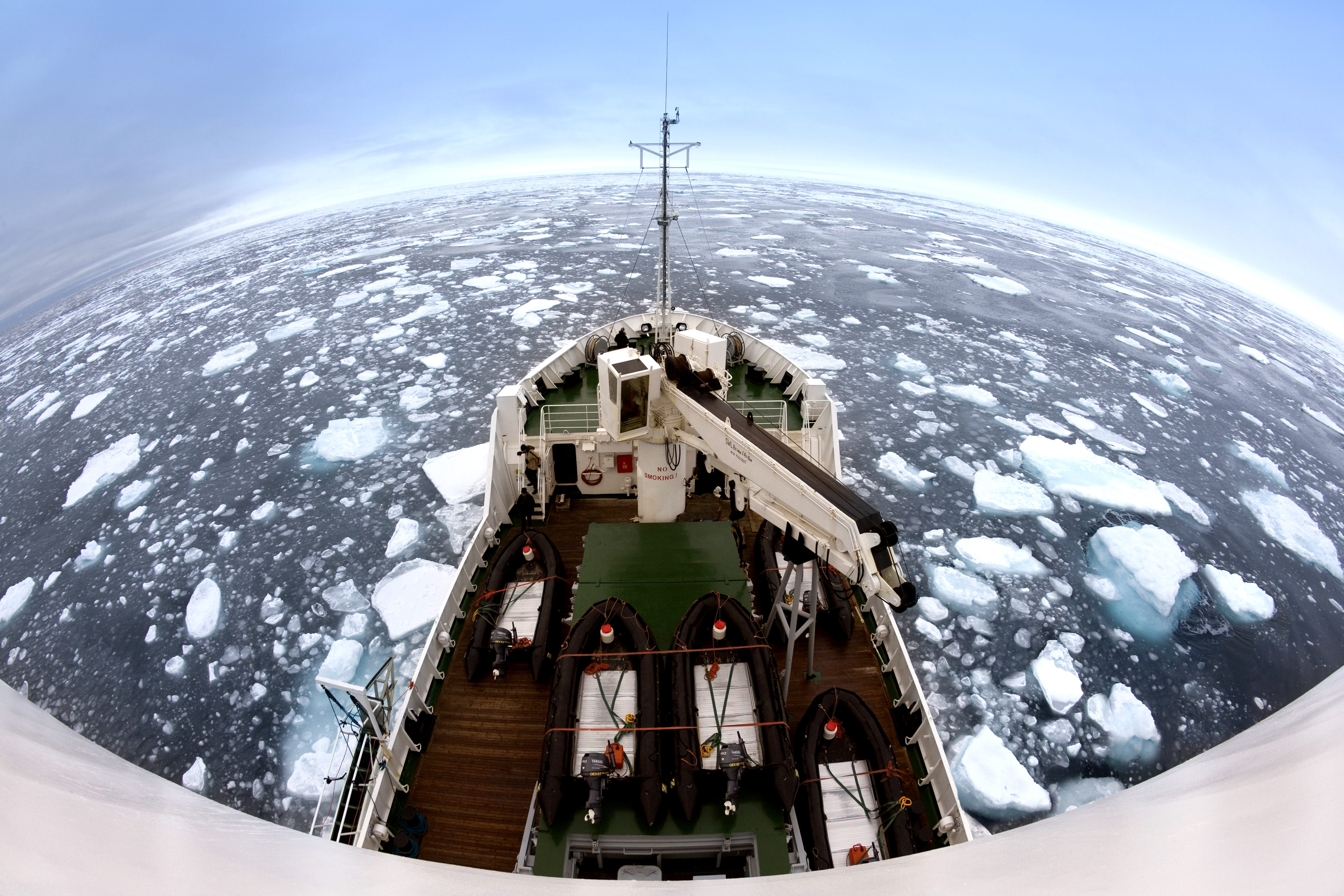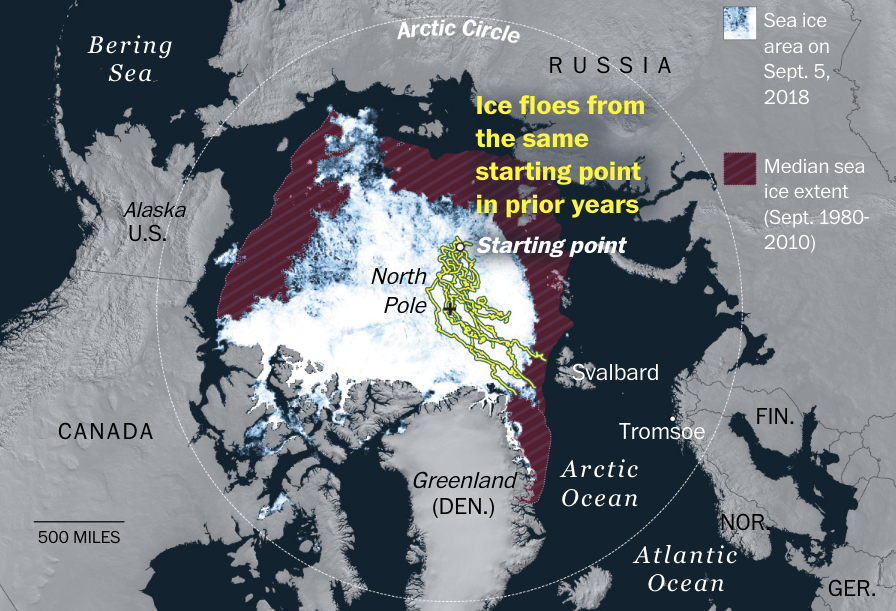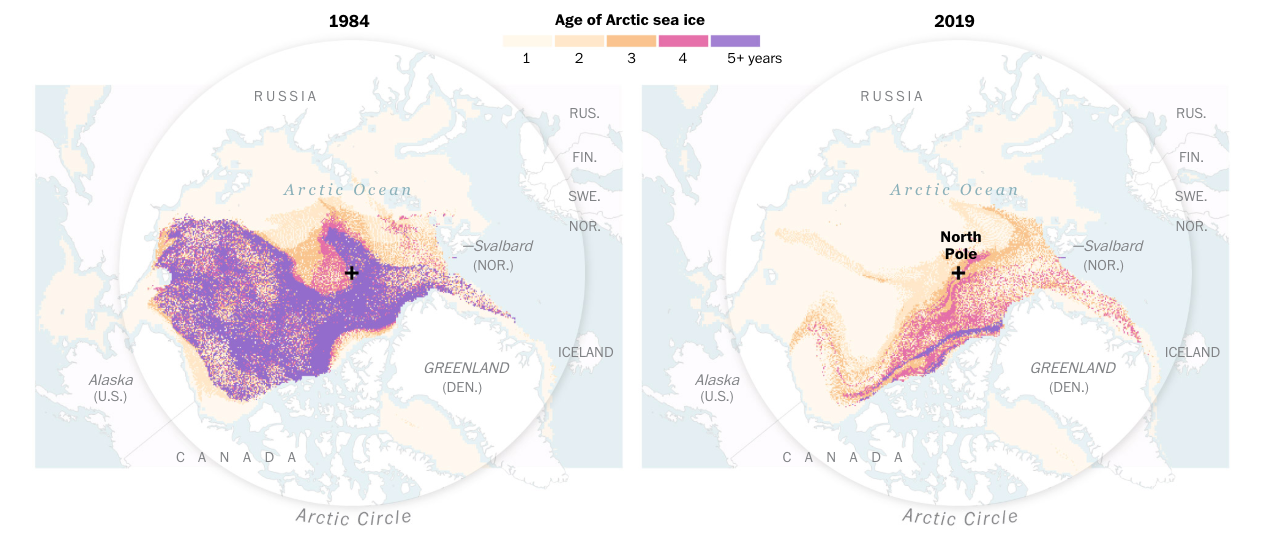Adrift in a melting Arctic
A multinational expedition will follow an ice floe as it drifts across the North Pole for a year. The scientists hope to better understand why Arctic ice is vanishing.

This article first appeared in The Washington Post. Used with permission.
Utqiagvik, Alaska — The scientists walk across a frozen Arctic Ocean, dark specks in a sea of white. Pale clouds loom low over the bundled figures. The wind sends ice crystals skidding and swirling around them, erasing their footprints.
Behind a large ice ridge, the group shelters from the subzero cold and 25 mph gusts to set up their experiment. They are learning to map an area's topography by shooting lasers across the ice and snow. But even their machines seem disoriented by the whiteout conditions: The lasers bounce off whirling snowflakes before striking their targets.
The Week
Escape your echo chamber. Get the facts behind the news, plus analysis from multiple perspectives.

Sign up for The Week's Free Newsletters
From our morning news briefing to a weekly Good News Newsletter, get the best of The Week delivered directly to your inbox.
From our morning news briefing to a weekly Good News Newsletter, get the best of The Week delivered directly to your inbox.
It's yet another problem they must solve before the fall, when these scientists and several hundred others will launch the largest Arctic research expedition in history: a 12-month, $134 million, 17-nation effort to document climate change in the fastest-warming part of the globe.
Home base will be a massive German icebreaker, though the ship will spend only a few weeks under its own power. After reaching a remote part of the Siberian Arctic, the crew will cut the engine and wait for water to freeze around the vessel, entrapping it.
Then the ship — and everyone on it — will be adrift, at the mercy of the ice.
What the scientists discover during their year in the frozen north will help them forecast the future of the entire planet. As Arctic ice vanishes, many scientists expect the steady stream of air that pushes weather across the Northern Hemisphere to wobble, producing periods of punishing cold, brutal heat waves and disastrous floods.
A free daily email with the biggest news stories of the day – and the best features from TheWeek.com
That's already happening. The polar vortex that gripped the Midwest this winter, the fires in California and lingering hurricanes such as Sandy and Florence are all thought to be domino effects of this instability. Unless humans take drastic action, Earth is on track to exceed the threshold for dangerous warming in a little over a decade, the U.N. has said. These scientists are racing against the changing planet to understand what's happening — and what is yet to come.
Struggling on the sea ice off Alaska during their training this April, they get a taste of how tough the task will be. They are steeling themselves for what awaits at the pole: profound isolation and protracted darkness, laborious experiments, cold that can plunge to 45 degrees below zero. There are countless ways the Arctic might thwart and threaten them at every turn.
"But if we can do this right," says Melinda Webster, a sea ice expert at NASA's Goddard Space Flight Center, "it's going to give us a huge leap forward in our understanding of Earth and how it's changing."
Shoulders scrunched, beards of frost forming on their balaclavas, she and her colleagues continue to collect what information they can. They have no choice but to keep going, Webster says. The world attempts an expedition of this size, expense, and risk only "once in a generation."
And hers might be the last generation that can.
If all goes according to plan, the Multidisciplinary drifting Observatory for the Study of Arctic Climate (MOSAiC) will begin on Sept. 20 — when the icebreaker RV Polarstern sets out in search of an ice floe to which it can pin its fate.
The ship will spend the next 12 months following that single floe through the central Arctic and across the North Pole — a 387-foot drifting research station inhabited by a rotating cast of some 300 meteorologists, biologists, oceanographers, and ice experts.
"We have so many questions that we can only get answers to there," says Webster, 33, who is part of MOSAiC's sea ice team. "Finally, this is our one shot to do that."
Nearly every northern nation is in on the project. Germany's Alfred Wegener Institute, a polar research center, is providing the Polarstern and leading the expedition. Russia, China, and Sweden have all contributed resupply vessels. Japanese experts have built flux chambers to measure carbon that moves from the sea ice to the atmosphere, and a Swiss team has developed an apparatus for sampling snow. The National Science Foundation and other U.S. agencies are contributing more than $25 million in grants, equipment and logistical support, making this one of the most expensive Arctic expeditions the NSF has ever funded.
About 60 people will be living and working on the Polarstern at any given moment; most have signed up for two-month stints, though a few may be onboard for half the year or more. Virtually their only link to the rest of the world will be the ships and aircraft scheduled to arrive every 60 days — winter blizzards and stormy seas permitting — to switch out passengers and restock food and fuel.
Simply getting to the Polarstern can take as long as a month; participants joke that it's easier to reach the International Space Station, 250 miles above the surface of the Earth.
The researchers will have no internet or phone service. They will work seven days a week, with free time granted only at the discretion of their research coordinators. Those on duty from December to February will never see the sun.
This is the only way to truly understand the far north, organizers say. There is no land here for a permanent research station, no open water to sail through. The Arctic demands to be studied on its own terms.
But the drift strategy has perils. Choose the wrong ice floe, and the scientists could end up in Russian waters, where outsiders can't collect data without special permits. Or the ice could carry them far to the west, beyond the reach of rescue missions should anything go awry.
Analyses of ice paths from previous years suggest that the ideal floe lies about 335 miles east of the North Pole. By the end of a year, it should deliver the Polarstern to open water somewhere between Greenland and the Svalbard archipelago.

A successful transpolar drift — one that didn't kill nearly everyone onboard — has been achieved just twice before in history: first by the Norwegian explorer Fridtjof Nansen, in 1893, and a decade ago by the small crew of a privately owned sailing ship called the Tara. The Polarstern will be the first modern research vessel to spend an entire year at the northernmost place on the planet.
No voyage has been as urgent, says Dartmouth geophysicist Don Perovich, who will sail with Webster on MOSAiC's June-to-July leg.
The 68-year-old researcher, a tall man with expressive eyebrows and an easy smile, first came to the Arctic in the 1970s. Then, the persistent cold at the top of the world was like the keystone in an arch: It helped stabilize Earth's entire climate system.
By 2011, when Perovich met Webster on a shipborne experiment, climate change had reduced the summertime Arctic's frozen area by half. Today, watching a visualization of the annual growth and melt of the sea ice, Perovich says, can feel like watching a heartbeat — one that gets fainter and fainter every year.
On MOSAiC, he and Webster will be studying the consequences of this loss. They know that as reflective ice gives way to dark open ocean, the water absorbs more sunlight, which accelerates warming and melts the ice even faster.
But there are other forces at play, ones that scientists have only begun to understand.
Azure melt ponds form on the ocean's frozen surface; like skylights, they let sunshine filter through the thinner ice and reach the water below.
Clouds rise from the open ocean, acting as both an umbrella and a blanket, and researchers aren't sure whether they're reflecting more heat or trapping it.
Algae cling to the bottom of the sea ice, inhaling and exhaling dissolved gases whose effects researchers can only guess at.
These are the mysteries facing MOSAiC, the questions it will take a full year and 300 scientists to begin to answer.
"This is a community puzzle," Perovich said. "And we all have a little piece."
In a brightly lit classroom at the Barrow Arctic Research Center in Utqiagvik (oot-ki-ahg-vik), three dozen MOSAiC participants get their introduction to the voyage ahead.
"What is your biggest concern out in the field?" asks Araina Danner, health and safety coordinator for the Ukpeagvik Inupiat Corp. (UIC), an Alaska Native organization that hosted the week-long training.
"Hypothermia," offers biologist Carin Ashjian. In the back of the room, someone else mumbles, "bears."
Danner nods. Polar bears are the largest land predator — bigger and more aggressive even than grizzlies.
She shows the trainees what to do if a bear threatens, standing with her arms extended and feet firmly braced. They mimic her, sheepish.
"See?" she says. "We're acting bigger, acting confident, staying together. [The bear] will be like, 'Hmm, not today.' " The group laughs.
Bears are no joke, not on MOSAiC. The project's 99-page implementation plan calls for the Polarstern to be encircled by nearly three miles of electric fence. The safe zone will be patrolled by a cadre of armed lookouts from 9 to 5 each day.
The researchers exchange looks, some anxious, most exhilarated. No matter their field, they are all adventurers, eager to test themselves against one of the planet's harshest environments.
They are also scientists, acutely aware of the connections between this remote region and the places where most people live. Their chief pursuit is data. That's what will let them make sense of a landscape that few others have even seen. That's how they'll feed the models that predict the consequences of warming around the globe.
The success of the mission hinges on collaboration. Because MOSAiC will last longer than any individual researcher's stint, each participant must grasp at least the basics of every problem the expedition will probe.
The mood is serious as the trainees head out onto the ice. There is a lot to learn. Atmospheric scientists are being taught to dig snow pits. Microbiologists are training to identify ice types. Everyone has to figure out how to ride a snowmobile without falling off.
Daniel Watkins, an atmospheric scientist and University of Oregon graduate student who has never before conducted fieldwork, learns what it takes to collect data he's always seen as simple numbers on a screen in computer models of Earth's climate.
The massive drill used to cut ice cores is taller than he is. It growls and shudders violently as he tries to press it into the ice.
"Whoa, whoa, whoa," yells his instructor, Jeff Bowman, a biologist at the Scripps Institution of Oceanography.
They are standing on a lagoon protected by the curve of Point Barrow, the northernmost spur of Alaska, where the frozen sea is nearly as flat and featureless as a skating rink. Above them, thin cirrus clouds streak a robin's egg sky.
Watkins stops the drill.
"Don't leave it in," Bowman says, quickly. If the bit stays in the drill hole, water might refreeze around it, trapping the instrument.
Rachel Lekanoff, a graduate student at the University of Alaska, Fairbanks, helps them heave the drill upward. After Bowman demonstrates how to better brace themselves, they resume their work. It's another 20 minutes before water finally burbles up around the drill — a sign they've reached the sea.
Gently, they pull the three-foot cylinder of ice onto the snow. To some scientists on MOSAiC, cores like this can contain a treasure trove of information about the saltiness of the ocean water, the temperature of the air above, even the microscopic organisms that dwell in tiny, briny air bubbles in the ice.
Watkins examines the product of an hour's work. "That was hard," he says.
On the expedition, researchers will have to collect as many as 30 of these cores in a day.
The Arctic is melting so quickly that an experiment like MOSAiC may not be possible for much longer.
For the drifting plan to work, the scientists need to lodge the Polarstern in a piece of "multiyear" ice — the thick, resilient sea ice that persists until the end of the northern summer. But, Webster says, "It's getting more difficult to find ice that's stable year-round."

During the NSF training in Utqiagvik, Webster leads a snowmobile trip to a towering ridge of multiyear ice a few miles offshore. The young scientist brims with energy; while the other researchers trudge through the snow, she bounds.
This is "the old Arctic," she explains, gesturing toward blocks of frozen seawater as big as minivans and blue as the sky. The ice has the rounded, worn appearance of an ancient mountain range — a legacy of the cycles of crushing and melting it has already endured.
Such thick multiyear ice has held this landscape together since time immemorial. In summer, it serves as a protective blanket, reflecting two-thirds of the sun's rays back into space and helping to keep the Arctic cool. In autumn, it subdues the waves whipped up by storms, preventing them from pummeling communities on the coast. It traps the ocean's heat in winter, and in the spring, it provides a solid, stable platform from which polar bears and people can hunt for food.
Back on the ice for the first time since earning her PhD three years ago, Webster smiles at her surroundings. A rime of feathery, frozen crystals catches the sunlight and glitters like fairy dust. The scattered slabs of ice resemble strange, stark sculptures.
"Beautiful, beautiful," Webster says. "Doing this work in this environment does make you feel a little more alive."
More than 95 percent of the Arctic's oldest, thickest sea ice — the kind that sticks around for four years or more — has been lost since 1980. And, according to the National Snow and Ice Data Center, the frozen seascape is 500,000 square miles smaller than the average since 1981. Overall Arctic sea ice levels in April, the month of the training, have never been this low.
And there, just to the north of Webster's ridge lies "the new Arctic": an expanse of fragile first-year ice that probably won't last the summer. Past that lies the open ocean, already a dark smear on the horizon, creeping closer every day.
Depending how the summer plays out, by the time MOSAiC sails the Arctic could contain less ice than at any time in recorded history. Late one night, in the sparse common room of their cramped dormitory, Perovich and Webster mull the changes to come.
Webster marvels that she will never know the Arctic that her mentor experienced as a young researcher. And who could say what kind of world she would share with her own future students?
"I'm always rooting for the ice," Perovich says.
But they both know the feedback loop between lost ice cover and warming water makes it more difficult for melted areas to refreeze. By the middle of this century, maybe sooner, scientists expect that no multiyear ice will be able to survive the endless day of the polar summer.
Then, for part of the year, the Arctic could be practically ice free.
Perovich says he thinks the summer ice "will stick around as long as I do." He nods to his younger colleague. "I don't know about you."
Webster pulls her knees toward her chest. Her expression is sober as she ponders the Arctic's future — and her own.
"I can't actually imagine what that would be like," she says.
"It's easy to imagine; you just erase all the ice," Perovich says. "What's hard to imagine is what all the ramifications would be."

